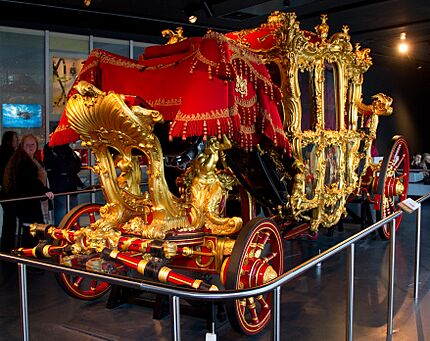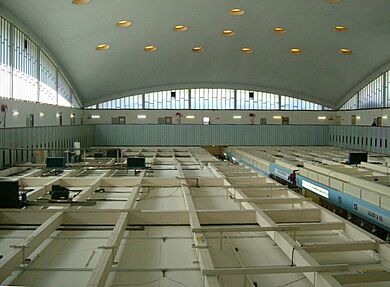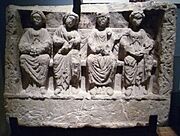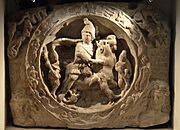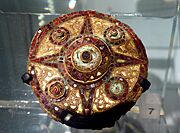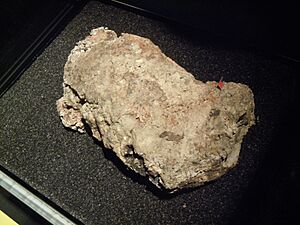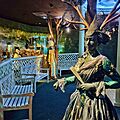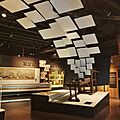London Museum facts for kids
 |
|

The entrance area of the old museum building in 2019
|
|
| Former name | Museum of London |
|---|---|
| Established | December 1976 |
| Location | 150 London Wall Barbican, London, EC2Y 5HN United Kingdom |
| Type | History museum |
| Collection size | 7,000,000 |
| Visitors | 141,835 (2021) |
| Public transit access | Barbican; St Paul's |
The London Museum tells the amazing story of London and its people, from ancient times to today. It was known as the Museum of London from 1976 to 2024. The museum was created in 1976 by joining two older museums: the Guildhall Museum and the London Museum.
For many years, the museum was located on London Wall, near the Barbican Centre. In December 2022, this location closed to prepare for a big move. The museum is getting a new, larger home at the old Smithfield Market. The new site is planned to open in 2026.
The London Museum has the world's largest collection of city history, with over six million items. It shows how Londoners have lived through the ages. You can see everything from ancient stone tools to modern art. Some famous items include Roman statues, beautiful old jewelry, and even a giant balloon of Donald Trump as a baby.
The museum is part of a group that also includes the London Museum Docklands, which is still open. The museum is run by the City of London Corporation and the Greater London Authority.
History of the Museum
Two Museums Become One
The London Museum was formed by combining two separate museums. The first was the Guildhall Museum, started in 1826. It focused on ancient Roman objects and other archaeological finds from the city.
The second was the London Museum, which opened in 1912 at Kensington Palace. It showed London's history in order, from prehistoric times to the modern day. It had rooms for different periods like the Tudor and Stuart eras, and galleries for costumes, toys, and paintings.
During World War II, both museums had to close. Afterward, people realized it would be better to join them. In 1965, a law called the Museum of London Act 1965 was passed to officially merge them.
The Museum on London Wall (1976–2022)
The new Museum of London opened in December 1976. Its building was specially designed with a one-way path through the galleries. Visitors would start in prehistoric times and walk through London's history up to the present day. The building even had a window looking out at a real piece of the ancient Roman city wall.
In 2010, the museum opened new "Galleries of Modern London." These galleries covered London's history from 1670 to today. They included a "Victorian Walk" with real 19th-century shops and displays on the suffragette movement for women's right to vote. Another gallery showed fashion from the 1960s punk scene to modern designers.
One of the most famous objects on display was the Lord Mayor of London's State Coach. This golden coach is used every year in the Lord Mayor's Show parade.
A New Home at Smithfield Market
In 2016, the museum announced its plan to move to a new home at Smithfield Market. The old building was hard for visitors to find, and the new site is much bigger. This means more of the museum's huge collection can be put on display.
The new museum will be in old market buildings. Architects Stanton Williams and Asif Khan are designing the new space. One exciting plan is to use spiral escalators to take visitors down into underground galleries. The museum also plans to reopen a Victorian café called the Temperance Cocoa Room that was discovered on the site.
The old museum building on London Wall closed in December 2022. The new London Museum at Smithfield is expected to open to the public in 2026.
Amazing Collections
The museum's collection has about 7 million objects, telling the story of London over 10,000 years.
Ancient and Medieval Treasures
The museum has thousands of prehistoric items, including the Havering Hoard. This is a huge collection of over 450 bronze tools and weapons from the Bronze Age.
The Roman collection is even bigger, with over 47,000 objects. These include statues from a Roman temple, jewelry, and even leather "bikini bottoms" that may have been worn by acrobats. Many of these items were found during building work in London.
The museum also has about 12,000 items from the Middle Ages, including over 1,350 metal badges worn by pilgrims.
-
A sculpture of four mother goddesses from Roman London.
-
A marble carving from the London Mithraeum, showing the god Mithras.
-
A Saxon brooch made of copper, gold, and garnets.
Modern London Life
One of the most famous collections is the Cheapside Hoard. It is a treasure chest of nearly 500 pieces of beautiful jewelry from the Tudor and Stuart periods, found buried in London in 1912.
The museum also shows how things were made in London. It has collections related to glassmaking, clockmaking, and silversmithing. There are also everyday objects like old shop signs, food packages, and toys.
The museum has an important collection of items from the suffragette movement. It also has thousands of hours of oral histories, which are recordings of people telling their own stories about life in London.
Collecting Today's History
The museum doesn't just collect old things. It also collects objects that are part of the news today.
- Whitechapel Fatberg: In 2018, the museum displayed a piece of a giant "fatberg." This was a huge lump of fat and waste that blocked a sewer in Whitechapel.
- Trump Baby Blimp: In 2021, the museum acquired the giant inflatable balloon of former U.S. President Donald Trump as a baby. It was first used in protests in 2018.
- Collecting COVID: During the COVID-19 pandemic, the museum asked Londoners to donate objects and stories. It collected everything from signs thanking the National Health Service to a football shirt worn by player Pierre-Emerick Aubameyang with a Black Lives Matter logo.
Fashion and Art
The museum has a huge costume collection with over 23,000 items. It includes dresses by famous designers like Mary Quant and Vivienne Westwood. There is also royal clothing, including a shirt believed to have belonged to King Charles I.
The art collection includes over 100,000 paintings, drawings, and prints of London. There are famous views of the city by artists like Canaletto and photos dating back to the 1840s. These pictures show how much London has changed over time.
Other Museum Locations
London Museum Docklands
In 2003, the museum opened a second location in a historic warehouse near Canary Wharf. The London Museum Docklands tells the story of London as a port city. It explores how the River Thames and trade shaped London's history. One of its most important galleries is "London, Sugar & Slavery," which examines the city's role in the transatlantic slave trade.
Museum of London Archaeology
Museum of London Archaeology (MOLA) is a team of archaeologists who were once part of the museum. Now, they are an independent charity. They dig up and study historical sites not just in London, but all over the UK and the world. They help us learn more about the past through the things people left behind.
Images for kids
-
The inside of a fancy lift from the Selfridges department store, from 1928.
-
An old taxi and lift panels from Selfridges on display.
See also
 In Spanish: Museo de Londres para niños
In Spanish: Museo de Londres para niños
- Culture of London
- London and Middlesex Archaeological Society


